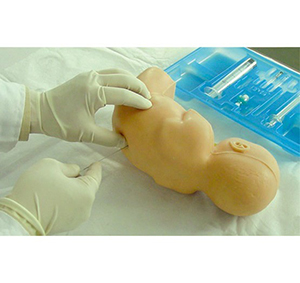Homepageпјҡ NEWS >> How can neonatal lumbar puncture models help build a better clinical training system?
Neonatal lumbar puncture is a common clinical operation in the fields of neurology, anesthesiology and pediatrics, especially in the diagnosis of meningitis, hydrocephalus and other neonatal diseases, it has important application value. However, due to the large difference between newborn anatomy and adult, the operation is difficult and prone to complications. Therefore, how to improve the operational ability of medical students and clinicians through scientific and systematic training has become an important topic in the field of medical education. The neonatal lumbar puncture model, as a highly simulated simulation tool, has been shown to play an important role in establishing a better clinical training system.
1. High-fidelity models help students master complex techniques
The technique of neonatal lumbar puncture is very delicate, involving the positioning of the lumbar puncture needle, Angle control, and avoidance of the spinal cord, nerves, and blood vessels. The high-fidelity neonatal lumbar puncture model simulates the anatomy of the newborn, such as the shape and size of the spine, epidural space, and subarachnoid space, thereby helping students to more intuitively understand and master the manipulation skills. Studies have shown that medical students using this model have a significantly improved success rate in actual clinical procedures, especially when performing this procedure for the first time, avoiding unnecessary injuries and errors.

Neonatal Lumbar Puncture Model
2. Reduce the occurrence of clinical errors and complications
Simulation training provides a risk-free environment for students to perform repeated operations and exercises without risk. The data showed that after the simulation training, the chance of puncture failure in the actual operation of medical students was reduced by more than 40%. The simulation model not only helps students understand how to accurately find the puncture point, but also helps them make quick and correct decisions when encountering complex situations, reducing possible complications such as spinal cord injury and epidural hematoma during the procedure.
3. Improve technical proficiency and ability to respond to emergencies
The use of neonatal lumbar puncture model not only helps to develop basic skills, but also improves the students' ability to respond to emergencies. In practice, many newborn lumbar punctures are performed in emergency situations, and the simulation model can reproduce a variety of complex clinical scenarios, such as changes in the patient's position and abnormal feedback during the puncture process. This repeated practice and the training to deal with unexpected situations will enable students to deal with different challenges more calmly and professionally in future clinical practice.
4. Establish a scientific evidence-based teaching model
The application of neonatal lumbar puncture model can promote the establishment of evidence-based medical education model. Through data tracking and evaluation, educators can clearly see the performance of students in simulation training, and give targeted feedback according to specific data. Some medical institutions have taken the simulation training results as one of the criteria to assess the clinical skills of students, thus establishing a more rigorous and efficient training system. For example, a hospital's training evaluation of its pediatric residents found that after 3 months of simulated training, the puncture success rate of students increased by about 30%, and the incidence of clinical complications significantly decreased.
5. Promote interdisciplinary training and teamwork
Neonatal lumbar puncture is not only a technical procedure, but also a manifestation of multidisciplinary collaboration, especially in emergency and intensive care, pediatricians, anesthesiologists, nurses, etc., need to work closely together. Simulation training makes interdisciplinary training possible, and students are able to collaborate with other professionals in a simulated environment, improving the efficiency of communication and teamwork. Relevant studies have shown that simulation training helps to improve the collaboration ability of interdisciplinary teams, so that they can cooperate more effectively in the clinical field to ensure the safety of newborns.
conclusion
The use of neonatal lumbar puncture models has played an important role in the medical education system. By simulating a real-world operating environment, participants are able to effectively master operational skills, reduce clinical errors, improve emergency response capabilities, and promote interdisciplinary team collaboration. Combining evidence-based teaching data and feedback mechanism, medical educators can evaluate the technical level of students more scientifically, and promote the continuous optimization and improvement of training system. Therefore, promoting the application of neonatal lumbar puncture model has far-reaching significance for establishing a more efficient and safer clinical training system.